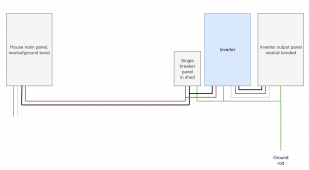This is how I currently have it setup, from what I've read there's no good/code way of setting one of these up with the grid attached.
I tried connecting the shed ground to the house ground without bonding neutral or connecting neutral to the house neutral and get nuisance tripping on the GFCI.
I tried bonding neutral with both grounds connected and got current flow on the ground conductor.
How bad is this setup? What are the risks in grid bypass mode? I know it's not code. From my understanding this is unsafe because the grid power doesn't have a low resistance return path in case of a short. I'm unsure if this is a concern only upstream of the inverter or downstream as well. I was pulling about 18 amps on one leg downstream and the load was exactly balanced between the two legs feeding the inverter.
I feel like it's either this or no grid input keeping the ground/neutral as is which will mean running a battery charger from grid in winter to keep it running. If I do just run a charger is there any issue with the equipment ground being shared between the house/shed. It would be very difficult to isolate them if I want to pull any circuits from the main panel into a subpanel since they're bare copper grounds. I didn't have any current on the equipment ground between buildings when in invert mode with neutral bonded, just when in passthrough mode.
If nothing else anyone have any inverter recommendations?
Side note, sparks fly when I run the internal battery charger, can't say I recommend.
Growatt doesn't say much of anything about the AC wiring but this is found in the sigineer version of the device.


I tried connecting the shed ground to the house ground without bonding neutral or connecting neutral to the house neutral and get nuisance tripping on the GFCI.
I tried bonding neutral with both grounds connected and got current flow on the ground conductor.
How bad is this setup? What are the risks in grid bypass mode? I know it's not code. From my understanding this is unsafe because the grid power doesn't have a low resistance return path in case of a short. I'm unsure if this is a concern only upstream of the inverter or downstream as well. I was pulling about 18 amps on one leg downstream and the load was exactly balanced between the two legs feeding the inverter.
I feel like it's either this or no grid input keeping the ground/neutral as is which will mean running a battery charger from grid in winter to keep it running. If I do just run a charger is there any issue with the equipment ground being shared between the house/shed. It would be very difficult to isolate them if I want to pull any circuits from the main panel into a subpanel since they're bare copper grounds. I didn't have any current on the equipment ground between buildings when in invert mode with neutral bonded, just when in passthrough mode.
If nothing else anyone have any inverter recommendations?
Side note, sparks fly when I run the internal battery charger, can't say I recommend.
Growatt doesn't say much of anything about the AC wiring but this is found in the sigineer version of the device.


Attachments
Last edited:



